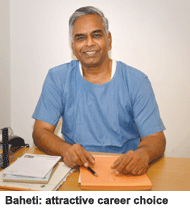Once a default career option of medical students, anaesthesiology is becoming an attractive career choice in its own right with demand far outstripping supply
“Anaesthesiology is a very important component of surgery operations, but most people are unaware that anaesthesiologists or anaesthetists are qualified medical practitioners. Until recently, we were always part of the backdrop. But of late this branch of medicine is being accorded the importance that other more glamorous branches of medicine enjoy. Once a default career option of medical students, anaesthesiology is now becoming an attractive career choice in its own right,” says Dr. Dwarkadas Baheti, professor and head of anaesth-esiology and the pain management clinic of the Bombay Hospital Institute of Medical Sciences, Mumbai.
According to Baheti, anaesthetists/anaesthesiologists are medical practiti-oners with specialist training in the administration of anaesthesia and medical care to patients before, during and after surgery. This includes preoperative medical evaluation of patients; planning a surgery with the surgical team; determining the dosage of anaesthesia to be administered to patients; airway management; intra-operative life support and pain control; intraoperative diagnostic evaluations and managing critical post-operative life support. “An anaesthesiologist puts patients to sleep for a particular purpose during which all vital life signs must be monitored continuously. In the post-operative period it’s her duty to restore the patient to consciousness as per plan,” explains Baheti.
 The prerequisite of qualifying as a certified anaesthetist is successful completion of the MBBS (bachelor of medicine and bachelor of surgery) degree programme (four and a half years with an additional year for internship). Thereafter the certification requirement is completion of the three-year Masters programme in anaesthesiology offered by most medical colleges in the country. Moreover in this new era of super specialisation, ambitious anaesthesiologists can specialise in cardiac, thoracic, brain, paediatric or plastic surgery, and/or pain management.
The prerequisite of qualifying as a certified anaesthetist is successful completion of the MBBS (bachelor of medicine and bachelor of surgery) degree programme (four and a half years with an additional year for internship). Thereafter the certification requirement is completion of the three-year Masters programme in anaesthesiology offered by most medical colleges in the country. Moreover in this new era of super specialisation, ambitious anaesthesiologists can specialise in cardiac, thoracic, brain, paediatric or plastic surgery, and/or pain management.
Given that India hosts a mere 600,000 qualified (allopathic medicine) doctors for its 1.2 billion population, there’s no dearth of work for anaesthetists with demand far outstripping supply. Most hospitals are equipped with a department of anaesthesiology or a panel of anaesthetists, on call. As preoperative physicians, anaesthesi-ologists work in ICUs (intensive care units), pain clinics, infusion centres, ambulatory surgical centres and disaster management teams. They are also often in charge of ICUs in most hospitals, since they have to take care of ventilation, fluid management, and all other vital systems of unconscious patients. Of late, pain management has become a critical function of these professionals. Little wonder the starting pay of duly qualified aesthesiologists is Rs.30,000-50,000 per month.
“This specialisation is attractive because as a practitioner you don’t need much capital to get going. You can be attached to a hospital or work as a freelance anaesthesiologist and all it takes to get started is a telephone, car and basic equipment, which is a far less expensive proposition than setting up private practice in any other branch of medicine. Nowadays, there’s a trend of starting pre-anaesthesia clinics, for which all you need is a consulting room. And if you are super specialised in pain management, you can promote a pain clinic for which there’s tremendous scope. A new development in medicine, there’s rising demand for pain manage-ment clinics in hospitals as well,” says Dr. Baheti, who has over 35 years experience as an anaesthesiologist and pain management researcher.
After acquiring his MBBS degree from the Dr. V. M. Medical College, Sholapur in 1970, Baheti read for his Masters in anaesthesiology at the Postgraduate Institute of Medical Sciences, Chandi-garh. In 1975 he began his career as an anaesthesiologist with the health ministry’s hospital in Iran where he acquired valuable experience for five years before signing up with Bombay Hospital in 1982 as a full-time anaesth-esiologist, rising to the position of professor and head of this renowned hospital’s unit of anaesthesiology and pain management clinic.
Deeply committed to pain alleviation, Baheti has established pain management clinics in the Bombay, Lilavati, Raheja and Shushrusha hospitals in Mumbai and has been bestowed numerous honours in India and abroad for his contributions to this particular science. Among them: organising chairman of the Global Update on Pain (1V) 2009; secretary general of the Global Update on Pain (2000, 2003, 2006); and president of the Indian Society for Study of Pain (2000-2001).
“Although the success of any surgical procedure depends on the surgeon’s skill, the other vital factor is the quality of anaesthesia treatment the patient receives. Today, we are witnessing advances in surgery which ensure there’s no morbidity and minimal mortality, and it’s in these areas that the anaesthetist plays an important role. There is so much specialised equipment in use in an ICU that training of anaes-thetists as intensive care specialists is crucial, and the demand for super specialised anaesthesiologists is growing by the day,” says Baheti.
In short, it’s the resurgent knock-out medical specialisation.
Indra Gidwani (Mumbai)